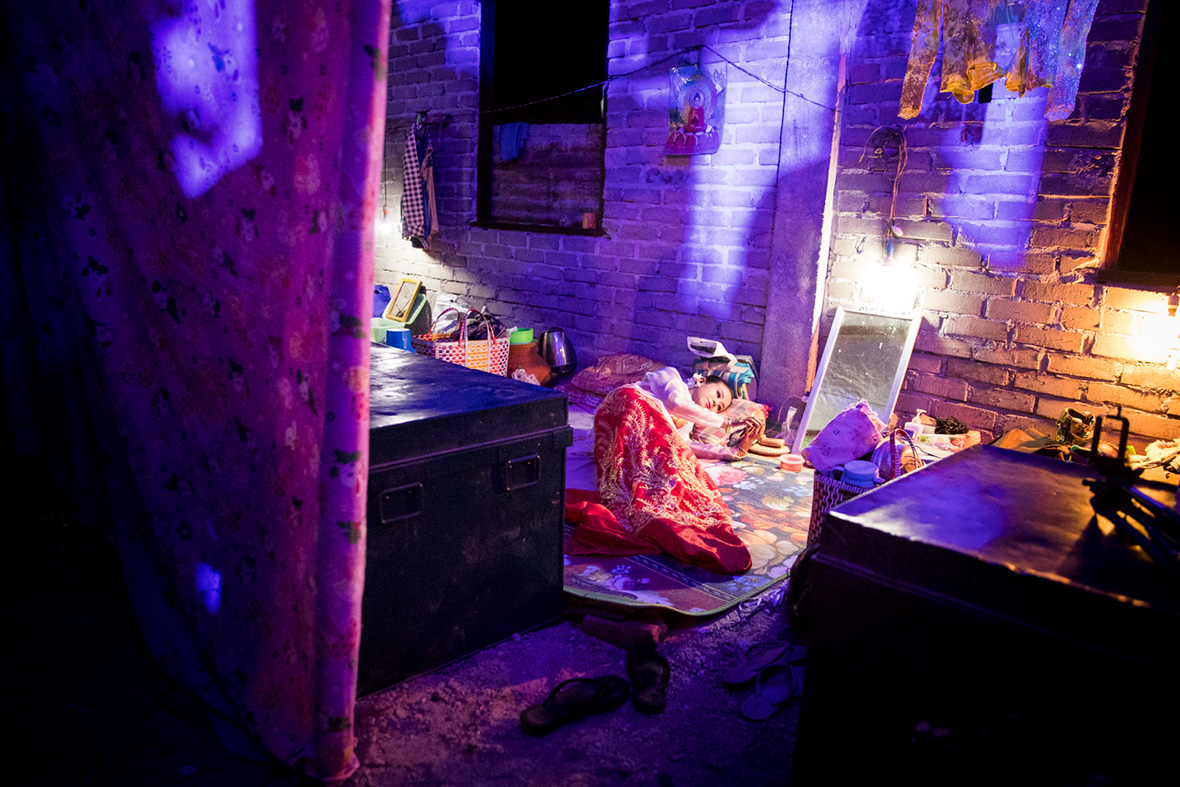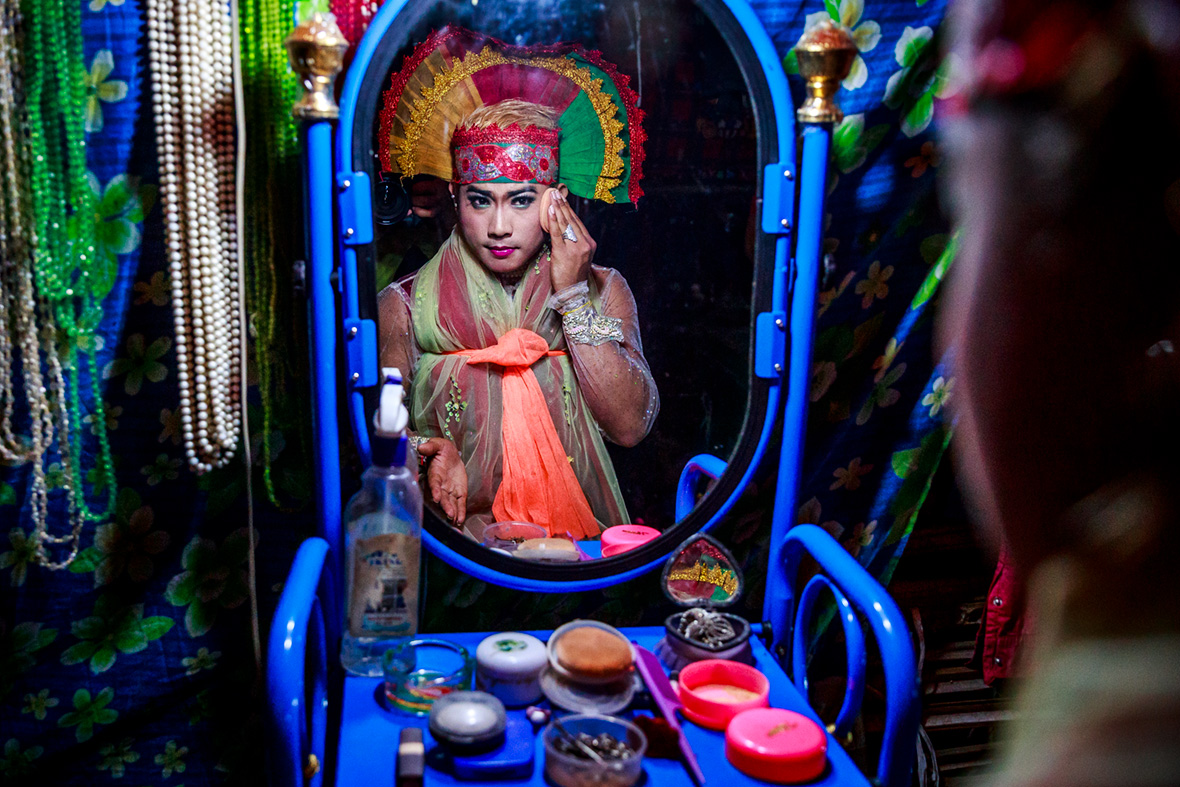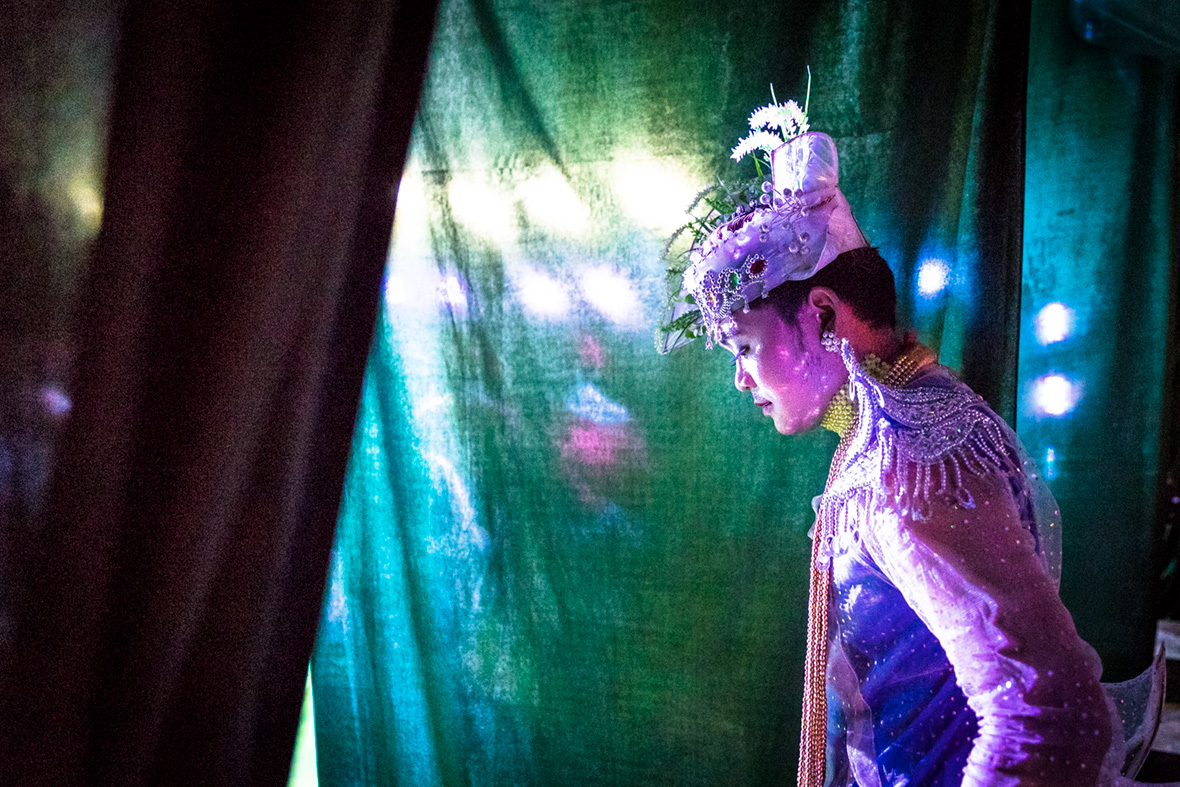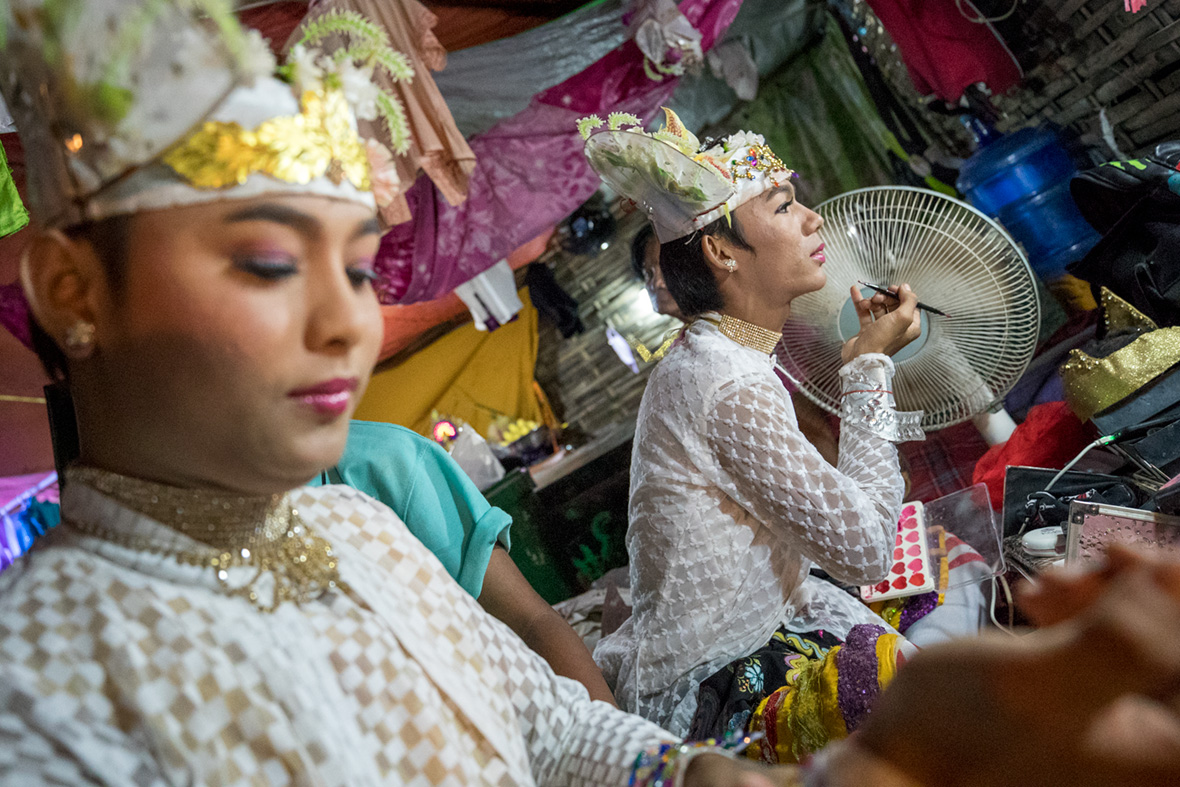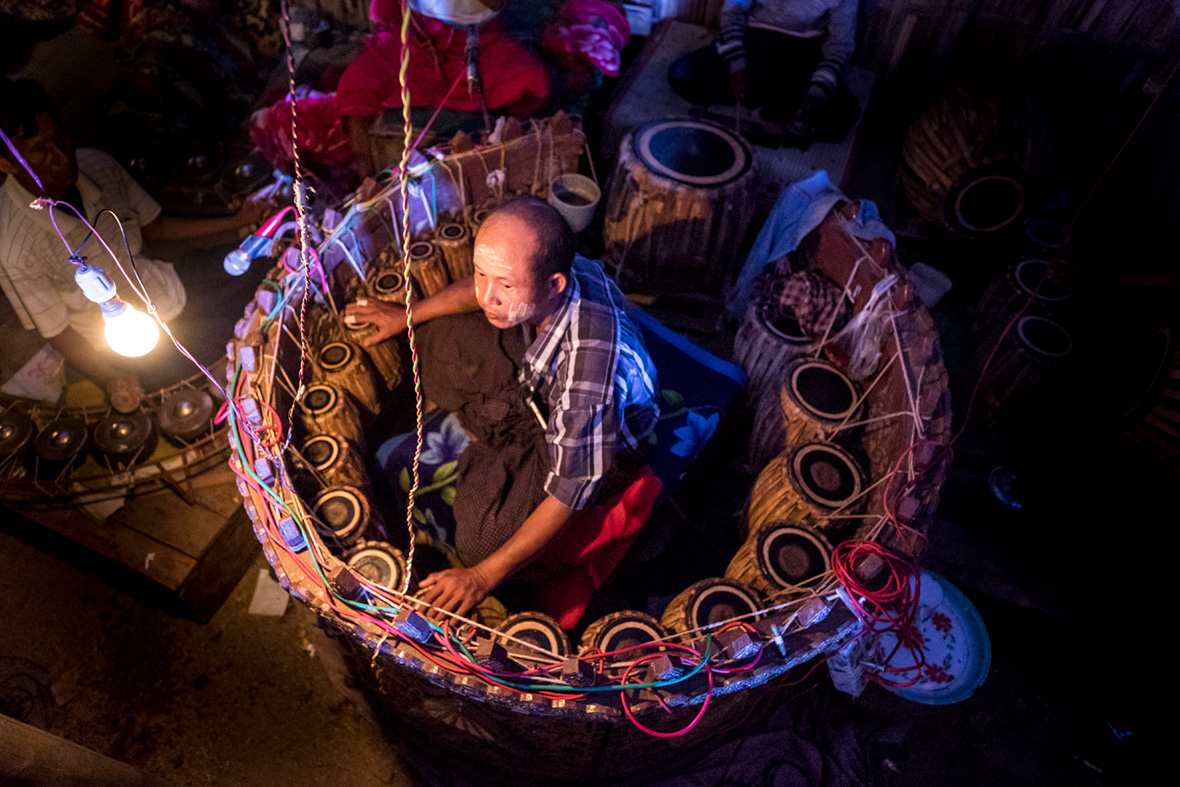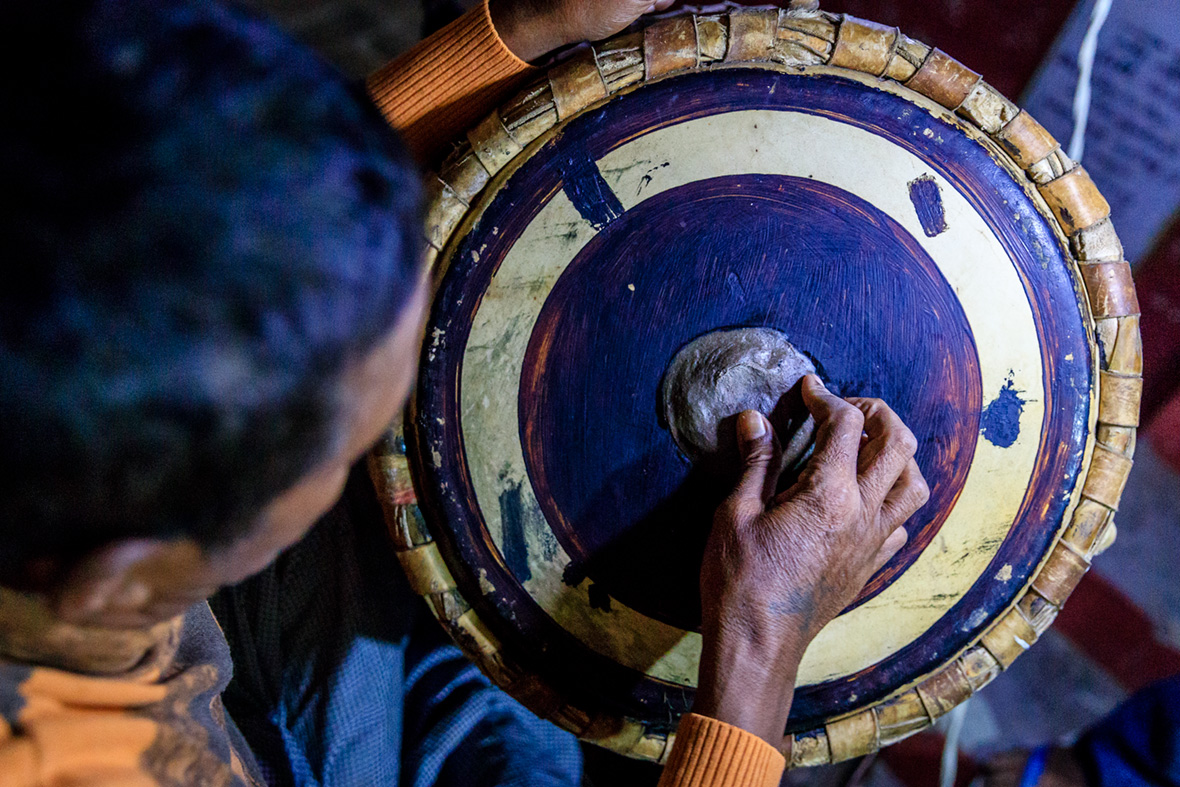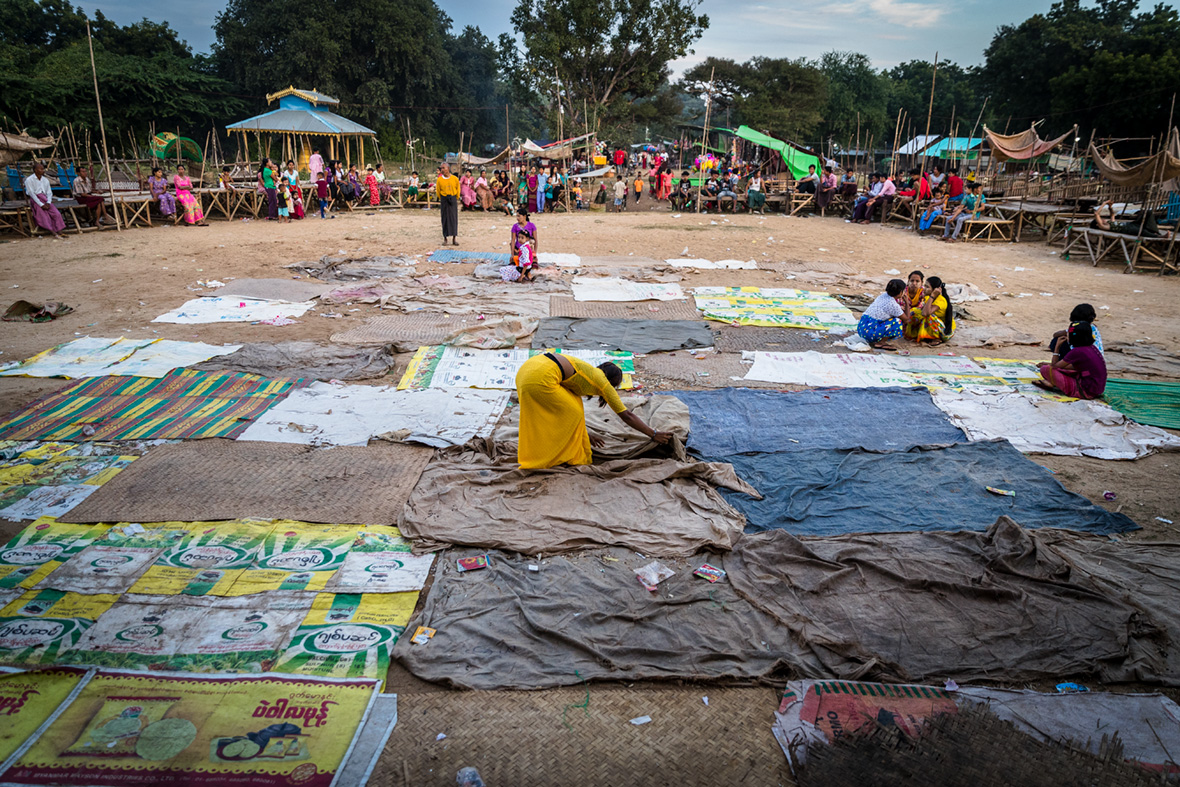
“In some way that I can’t define to you, the whole life and spirit of Burma are summed up in the way that girl twists her arms.” — George Orwell, Burmese Days.
Under a gleaming magenta light, a slim young girl, intricately dressed, dances to orchestra music. She twists her arms, hips, and legs in movements carried through generations as she performs on an open-air stage made of bamboo, palm leaves, and tarp. Before her, a lively audience sitting on mats laid out on the bare ground watches on. This is Burmese Zatha Bin, an all-night variety show combining theater, dance, and music, composed of traveling troupes that tour Myanmar’s rural areas.
“对我而言,缅甸女孩子在空中扭动的手臂,或像是当地人生活与精神的一道缩影。” —— 乔治·奥威尔,《缅甸岁月》
明晃的洋红色灯光中,身材苗条的年轻姑娘穿着精致华丽的服装,她正翩翩起舞,身后传来民间管线乐队的声响。在由竹子、棕榈叶和篷布搭建的露天舞台上,姑娘的手臂、胯部和双腿灵活地在空中扭动。正对她的,是围着垫子席地而坐的人群,他们全神贯注,看得入迷。这种名为 “Zatha Bin” 的缅甸传统舞蹈,如今已在当地经历了数代人传承;其融合了戏剧、舞蹈和民间音乐,令人眼花缭乱,有时甚至可以通宵达旦。在缅甸当地,由专门的剧团带队,游走在各个乡间。
A different world exists backstage, where dozens of musicians, dancers, actors, and crew members congregate and prepare before and during the show. That’s what Burmese photographer Zarni Myo Win chose to portray in his series Behind the Curtain. Following 15 different Zatha Bin troupes throughout Myanmar, his series not only documents moments backstage but captures the performer’s lives and the contrasting reality that builds up to the spectacle.
“I followed them to take detailed photographs of how they moved from one place to another, how they set up the show, how they perform, where they stay, and what they eat,” he says. “If I were to express my experience in words, it would be an account of too many pages.”
走下舞台,幕后又是一个截然不同的世界:几十位乐手、舞蹈家、演员和剧组成员齐聚一堂,忙得不可开交。缅甸摄影师 Zarni Myo Win 跟随 15 个不同的 Zatha Bin 舞蹈剧团前往缅甸各地,用镜头捕捉这个后台世界,最终完成了《Behind the Curtain(幕后)》系列作品。
照片上,真实的生活环境以及幕后的片段,与舞台上形成了鲜明对比。 “我的镜头深入到整个剧团,希望能捕捉下每一个细节,包括吃、住、行以及现场的布置、甚至跟随他们体验舞台在不同地方之间的迁移和搭建。如果将这段经历以文字整理出来的话,我可以洋洋洒洒写上好几页纸。” 他说道。

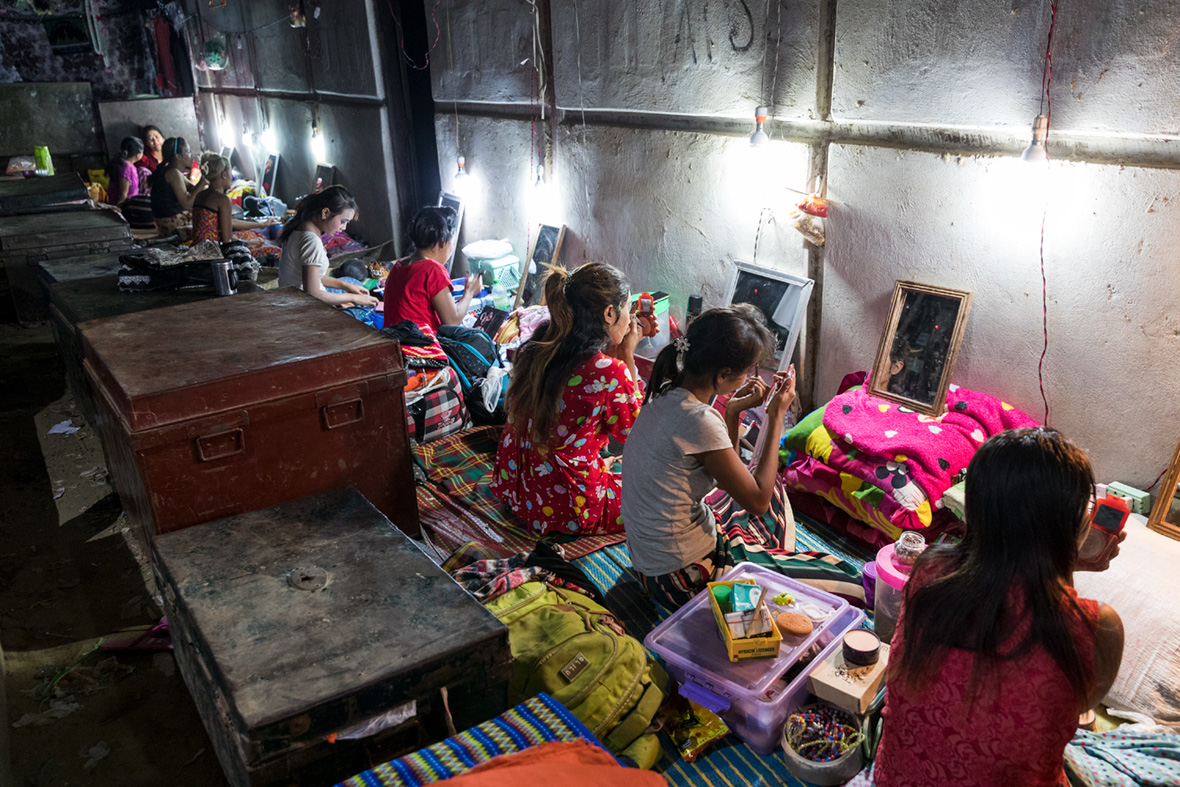
Many images feature the performers putting on makeup and getting into costume, their glamour not diminished by the rustic ambiance around them—tiny rooms of tarp walls litten only by one or two hanging bulbs. It’s where they sit or squat, gazing at small plastic mirrors, and where they spend their time for, on average, 150 days a year. It’s where they eat, have their cigarette or cheroot breaks, rest, and sleep, surrounded by the amalgam of tools, props, and personal belongings they carry on their peripatetic lives.
拍摄大都在由篷布搭建的不大空间里进行,只有一个或两个挂起的灯泡勉强起到照明的效果。不过,表演者的魅力并未因简陋的空间而减弱。在这里,他们常常蹲坐在小小的塑料镜前梳妆打扮,就连每天的吃饭、睡觉、抽烟都在这堆满了杂物和工具的环境中进行。一年平均 150 天,他们都在这样的小房子里度过,过着漂浮不定的生活。
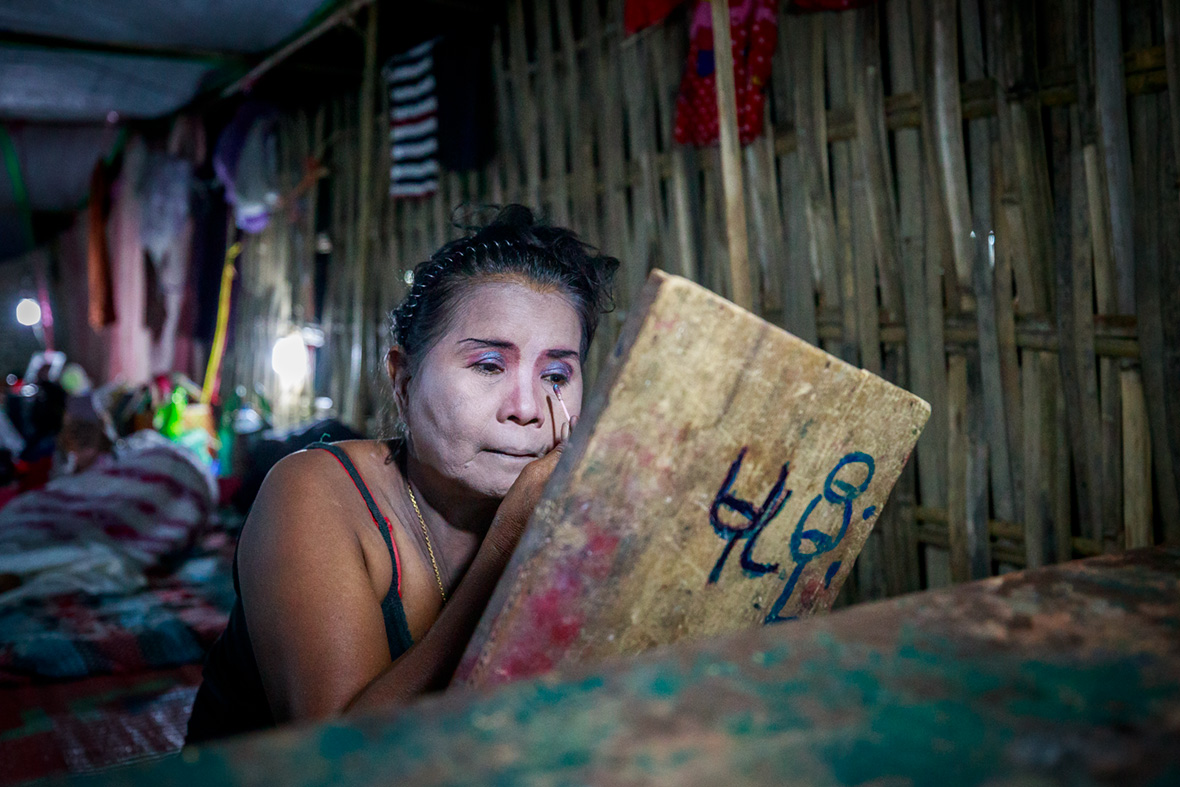
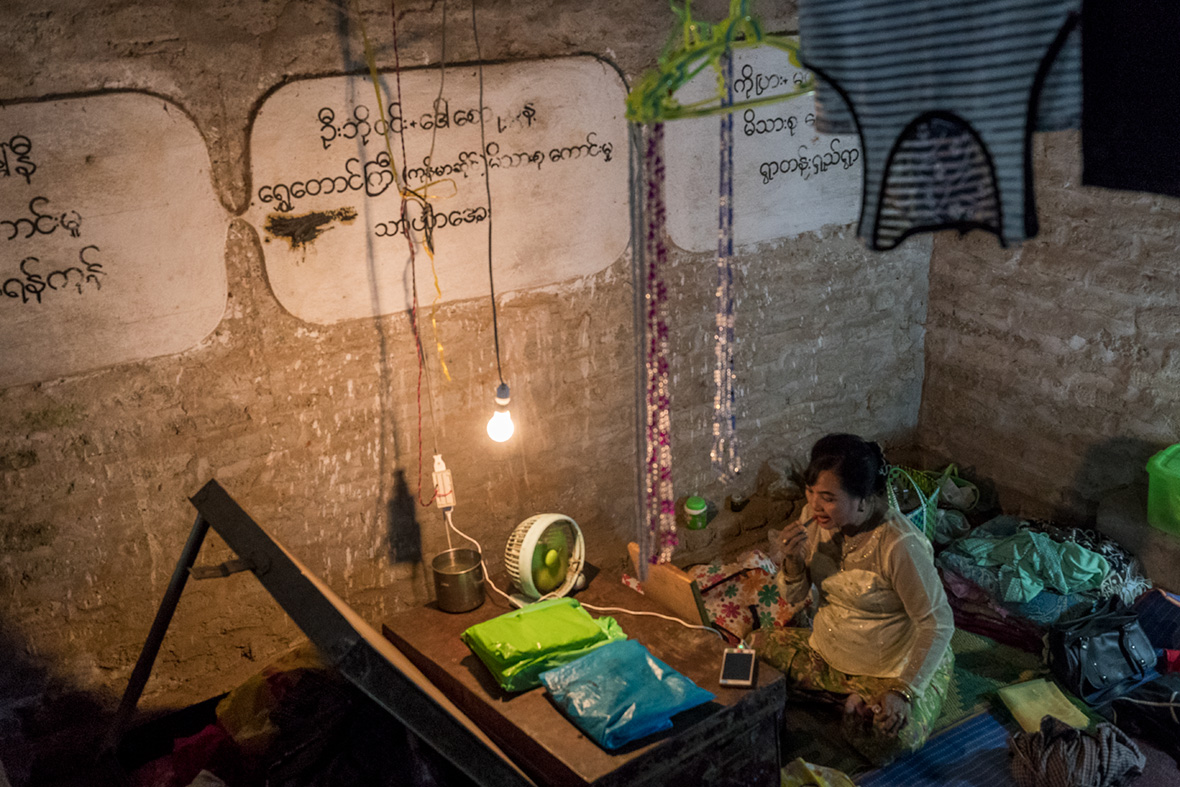
While some of the troupers are art-school graduates, most of them worked in agriculture, low-income service jobs, or hard labor. In a country of oppressively low salaries, joining a Zatha Bin as a trouper is an additional source to make ends meet, even if it’s only of minor help. “For an all-night-long performance, they still earn a minimal wage, which they call ‘night-shift fee’ which is about K10,000 ($8),” Zarni Myo Win says. “I find their lives harder than ordinary people’s lives.” He gives an example of a female trouper who performs in the night’s latest act (that’s early morning) and doubles as a waste collector picking up plastic bottles and other recyclables left onsite when the show is at rest.”
剧团中少数演员来自艺术院校毕业生,绝大多数则由农业、低收入人群组成,一些人甚至平时还做着杂工和苦力。面对缅甸国内低收入的残酷现实,加入 Zatha Bin 舞蹈阵营是额外收入的选择之一,但挣得也并不算多。“演出通常会持续一整晚,但费用却还是不尽如人意。这种被称为所谓的 ‘夜班’ 费用,一般在 10000 缅元左右(人民币 52 元左右),” Zarni Myo Win 说道。“我发现他们演员比一般普通人的生活还要苦。” 他甚至曾看到一些团内成员在演出结束后收集废弃的塑料瓶,赚取额外的费用。
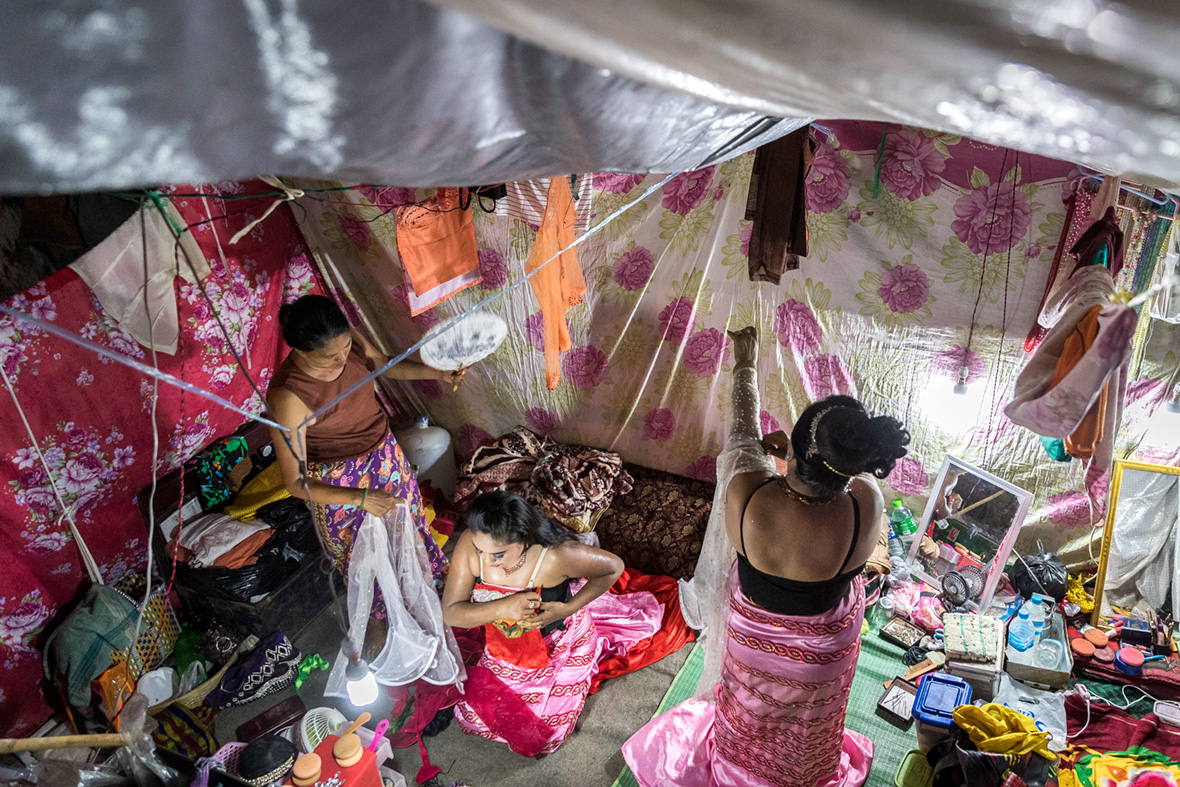
A fascinating aspect of the series is the variety of unique musical instruments he depicts. The heart of any Burmese music ensemble is the Pat Waing, a large horseshoe-shaped percussion instrument made of 21 drums, and the Ci Wain, with a similar form but smaller and made of gongs. In both, the percussionist sits at the center to play. The musicians’ intimacy with these instruments is evident in Zarni Myo Win’s photos where they’re shown resting or sleeping atop of them. Their ability to find comfort in discomfort seems to personify the whole troupe’s attitude.
此外,照片中五花八门的独特乐器也格外吸人眼球。围鼓(Pat Waing,由21个鼓组成的大型马蹄形打击乐器)和围锣(Ci Wain,其形状与围鼓类似,但较小,由锣组成)在缅甸民间音乐中扮演核心角色。演奏这两种乐器时,乐手需要盘坐在由鼓组成的环形中央。在 Zarni Myo Win 的照片中,可以看出乐手与这些乐器之间的亲密联系,他们甚至可以与乐器共枕同眠,这种 “苦中寻乐” 的姿态也体现了整个剧团面对生活的态度。

Out of the spotlight, but equally essential to each show, are the stagehands. In Zarni Myo Win’s photos, they’re often seen holding or sitting next to rope cords and indirectly illuminated by the stage lights. On their faces, not heavy stage makeup, but dried thanaka, a yellowish-white paste that the Burmese people have traditionally worn for thousands of years. Many seem to marvel at the performances unfolding onstage. “Some of them became professional troupers too, slowly, after they join the group as general workers,” Zarni Myo Win explains.
聚光灯之外,管理员同样是舞台必不可少的角色。照片中,他们紧握绳索,或坐在绳索旁边,面孔总被舞台灯光照得通红。脸上没有厚厚的妆容,取而代之的是檀娜卡粉末( Dried Thanakha)。这种粉末是缅甸当地传承了两千年的黄白色香木粉浆,有消暑、防晒、美白、保湿的功效,也可以在面部图绘出不同的图案。管理员们注视着舞台上的表演,檀娜卡粉末在灯光的照耀下醒目。Zarni Myo Win 说道:“他们中的一些人以普通员工的身份加入剧团,但慢慢也会成为这里的演员。”
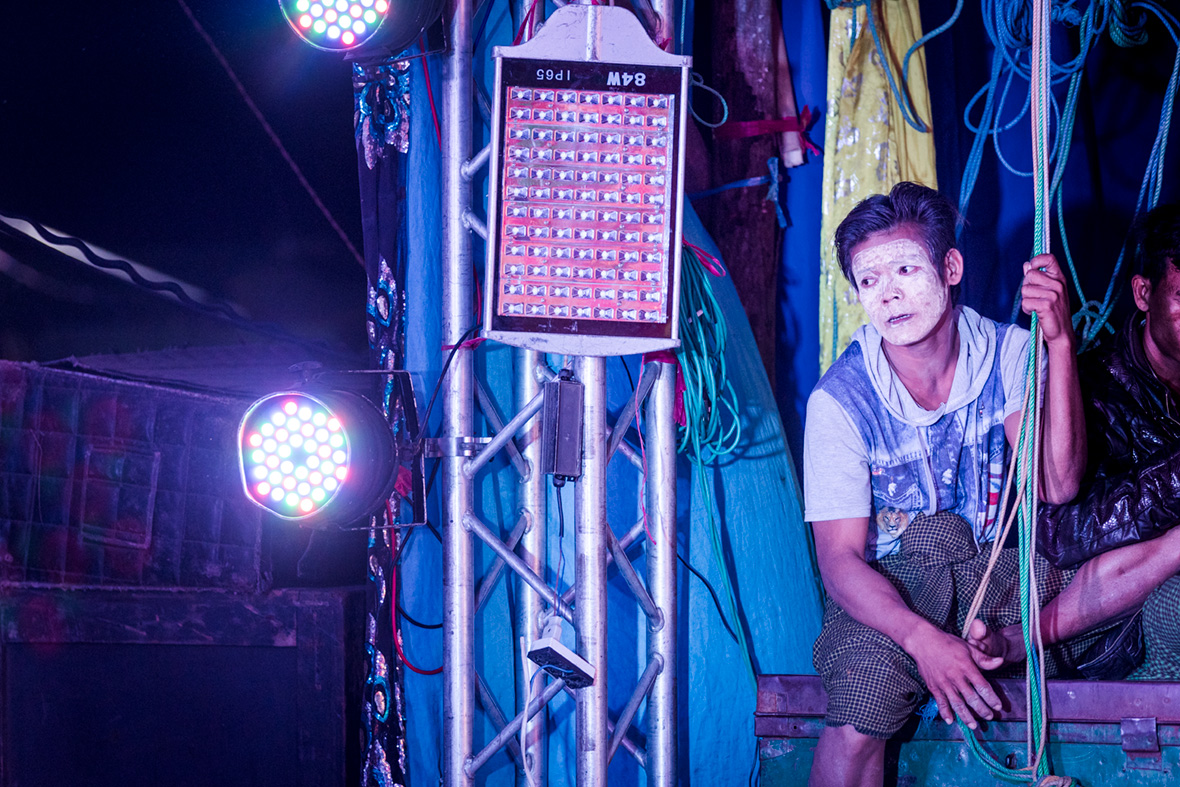
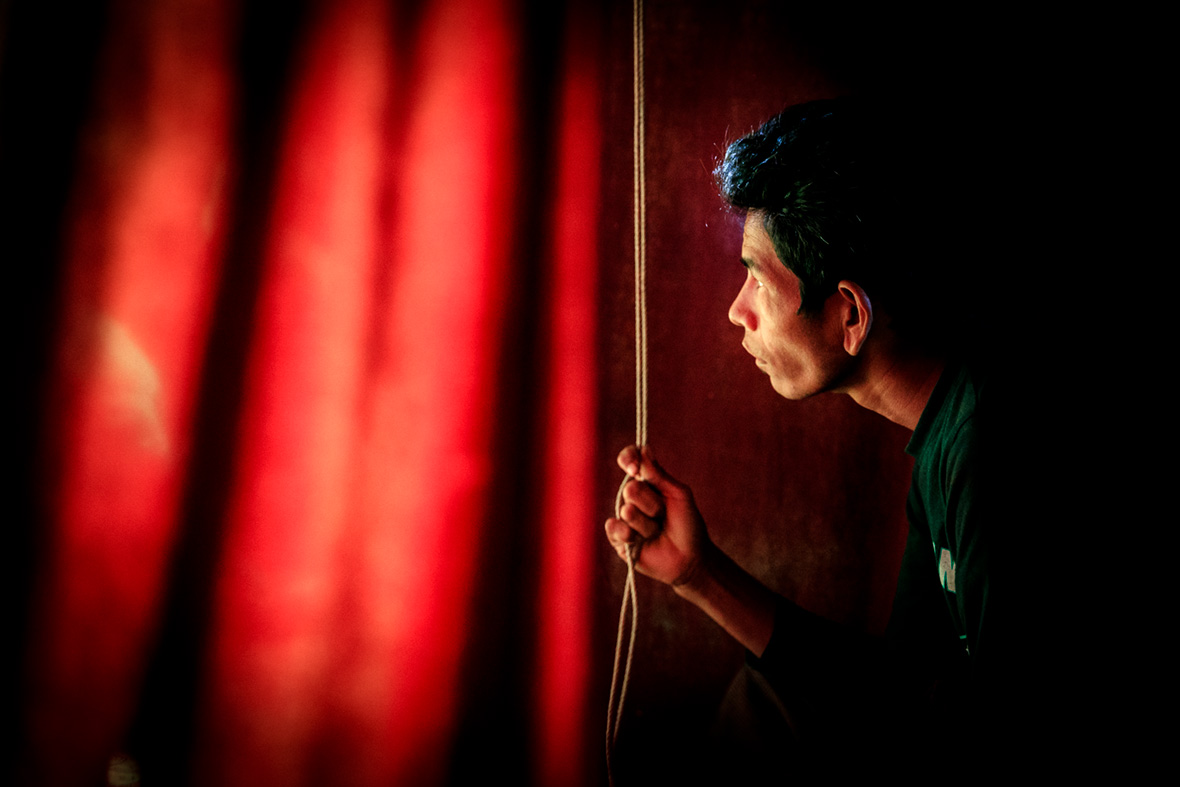
At dawn, the whole group breaks camp and moves to the next village in a small procession of trucks and cars. Their travel conditions are akin to their living standards, and road safety is not improving, but rather deteriorating in the country. Zarni Myo Win aches at the memory of a tragic accident he witnessed: a truck tipped over, killing six or seven dancers. However, such a sad recollection exists amidst warmer and happier ones, of when he shared meals or tea with the troupers, having long conversations about their culture and life.
黎明时分,剧团的人们开始拆卸帐篷舞台,他们纷纷坐上卡车和汽车,前往下一个村落。缅甸的出行条件与生活状况不相上下,道路安全的问题尚未得到改善,反而在不断恶化。Zarni Myo Win 难过地回忆起他曾亲眼目睹的一场事故:一辆卡车侧翻,6、7 名舞者因此丧生。不过在这些悲伤的回忆之余,也夹杂着温暖和快乐:他时常与剧团演员一起吃饭喝茶,盘谈甚欢,渐渐地熟悉了他们的文化和生活。
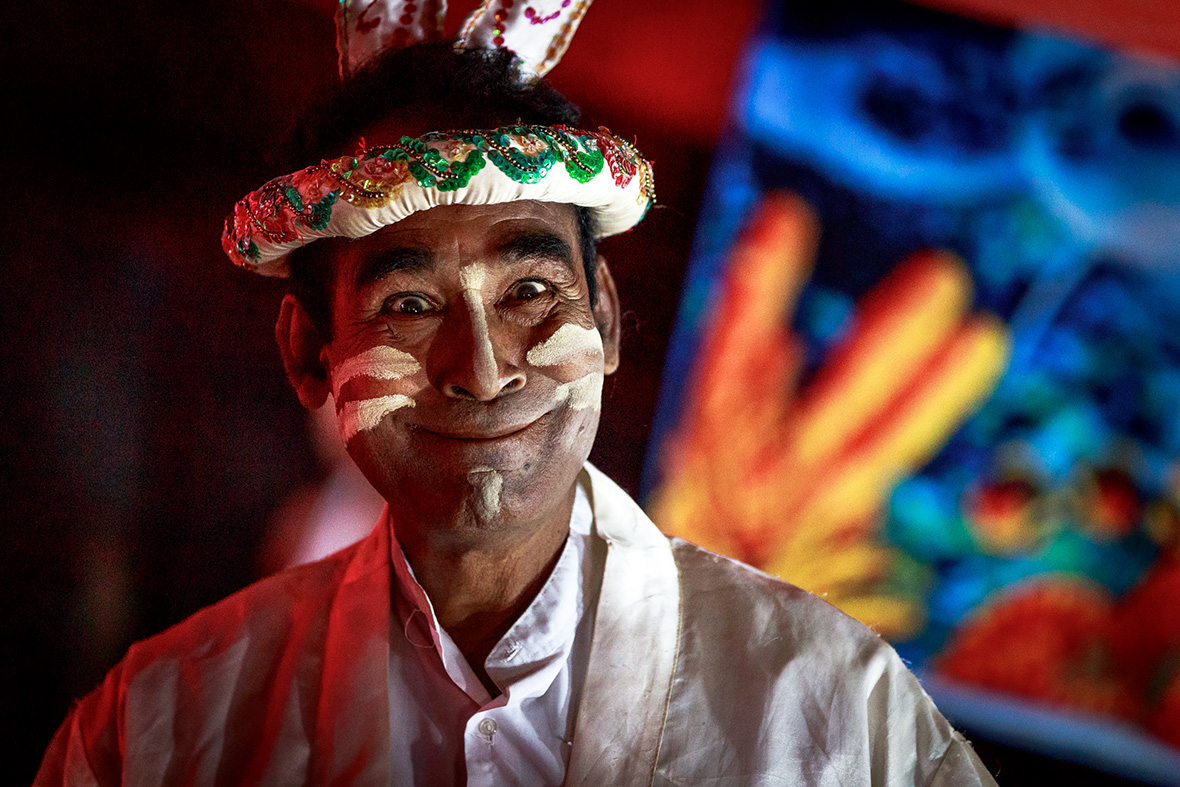
Even more troubling nowadays is the fact that Burmese Zatha Bin is in peril. For decades, it thrived in regions with very few entertainment alternatives. In a country where television is still not widespread in rural areas, it brings communities together and deepens the sense of national character. Unfortunately, the imminence of modernity, cell phones, and the internet has taken its toll on the tradition.
Since performing-arts schools are not well developed in Myanmar, knowledge is generally handed down from one generation to the next, a gift passed on in family lines for over one hundred years. “For example, now, oboists are having a hard time passing on their ability to younger people; most are not interested anymore,” says Zarni Myo Win. “Besides, their earnings don’t even cover the operation costs. What keeps the tradition alive is their passion.”
如今,剧团正面临当下一个令人不安的事实 —— Zatha Bin 正不断从大众视线里消失。几十年来,Zatha Bin 表演在娱乐活动极度匮乏的地区得以蓬勃发展;在一些农村地区,电视机还没有被全面普及,剧团的表演能让社区的人们聚集在一起,加强人们的民族认同感。然而,随着现代化的发展,手机和互联网的普及对这种传统文化带来了新的冲击。 由于缅甸的表演艺术学校发展尚不成熟,一百多年来,这些表演知识通常都是靠家族内世代传承。Zarni Myo Win 说:“一些双簧管吹奏家现在已经很难找到继承人;大多数年轻人都不感兴趣。除此之外,剧团的收入甚至不够支付运营成本,他们只是凭满腔的热血在坚持这项传统。”
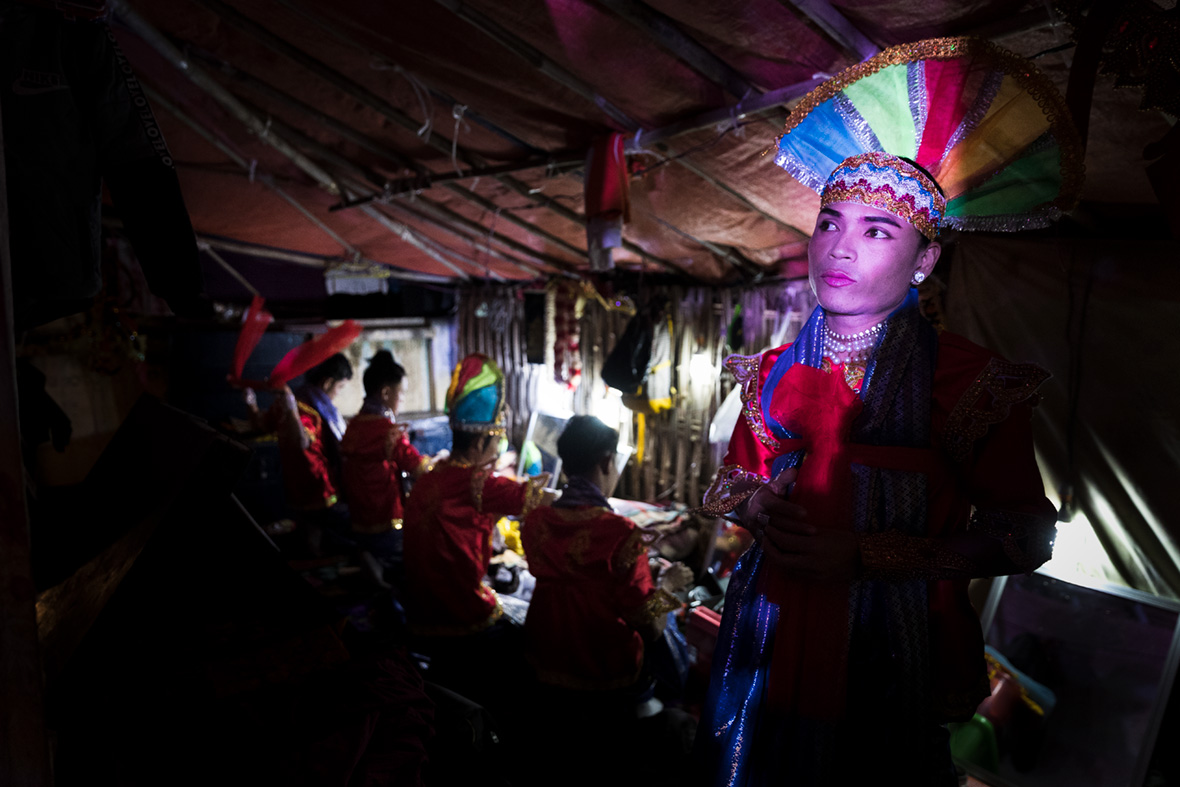
The trouper’s perilous conditions are palpable in Behind the Curtain. The series is a cautionary tale of what can happen to culture if not cherished and respected. But it’s also a register of how it endures prompted by the creative passion of a few dreamers. Zarni Myo Win’s series is the complex mosaic of these dreamer’s lives, a dazzling marriage between intent and exertion, which is perhaps best symbolized in the pictures of certain performers getting into character, ready to enter the stage, the moment of trance when they leave the world behind as they step out from beyond the curtains.
你能在《Behind the Curtain》系列摄影中感受到,传统艺术在缅甸社会现实下的不堪,同时还有那些满怀梦想的执着。Zarni Myo Win 的这一系列摄影作品为人们拼凑出梦想家的方方面面,展示了理想与汗水的交融。其中最具有代表性的莫过于演员上台前的准备画面:当他们进入角色,那一瞬间令人觉得恍惚,他们从幕布中走来,离开背后的世界,踩在聚光灯下,双臂扭动出现实之外的另一个自我。
Like our stories? Follow us on Facebook and Instagram.
Website: www.zarnimyowin.com
Instagram: @zarno_myo_win
Contributor: Tomas Pinheiro
Chinese Translation: Olivia Li



